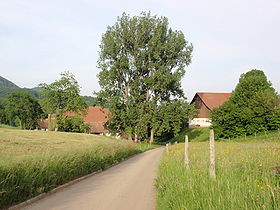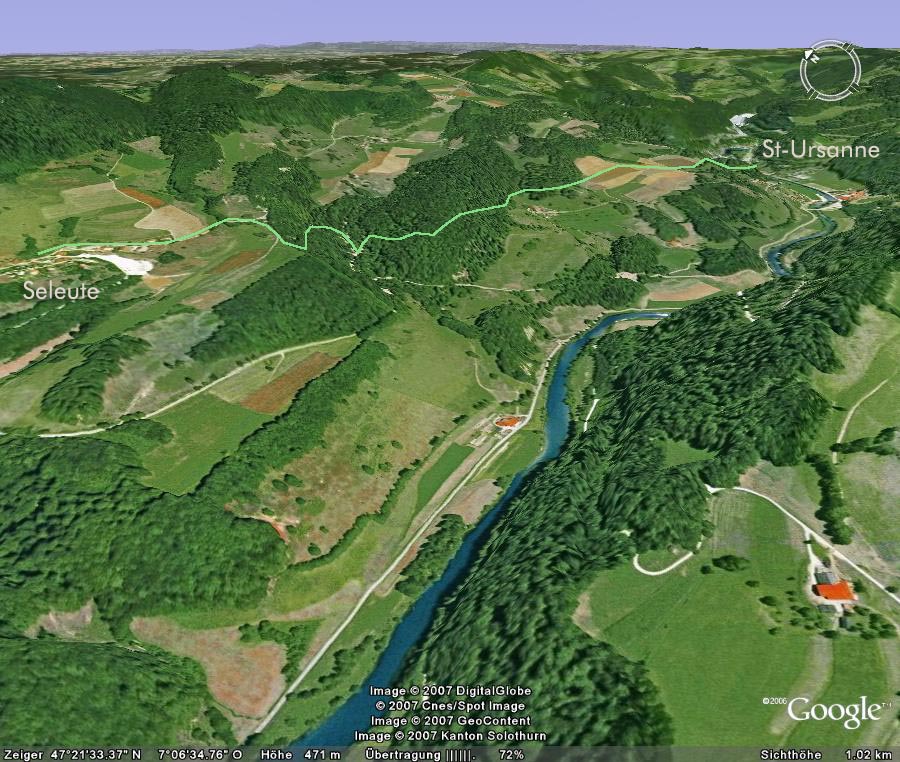Seleute
Seleute
Seleute ( FC. [( ɛ ) slœt ]; rebuke German ) is a village and a former municipality in the district of the Swiss canton of Jura Porrentruy.
Geography
Seleute situated 650 meters above sea level. M., 6 km south-southeast of the district municipal seat Porrentruy (air line). The farming village extends on a terrace on the northern side of the valley of the Doubs River, approximately 200 m above the valley floor, the Jura Mountains.
The area of 6.8 km ² large former municipal territory comprises the southern slopes of the Jura range Lomont, which is divided by several small erosion valleys and a front terrace. The northern boundary was in proximity to the ridge (usually beyond the watershed ) over La Gravière ( 857 m above sea level. M. ), La Joratte (901 m above sea level. M. ) and reached the plain of Mont de Monnat with 902 m above sea level. M. the highest point of the municipality. In the far east the territory handed to the pass Sur la Croix the main road from Courgenay to Saint- Ursanne. Seleute possessed a greater exclave on the opposite side of the Doubs, the Clos du Doubs, on the northern slope of the Fin du Teck (up to 800 m above sea level. M. ). From the municipality surface 1997 2 % came from settlements, 55 % of forest and woody plants and 43% to agriculture.
To Seleute included several individual farms. Neighboring communities of Seleute were Saint- Ursanne Montmelon Epauvillers, Epiquerez, Ocourt and Courgenay.
Population
With 72 inhabitants ( end of 2007) Seleute is one of the smallest municipalities in the canton of Jura. Of the 95.5 % inhabitants are French-speaking and German-speaking 4.5 % (as of 2000). Since 1850, the population has decreased by about 150 inhabitants at that time by about half. 1900 116 inhabitants were still counted.
Economy
Seleute is an embossed through farming village, where the livestock and dairy farming outweigh anything besides farming and fruit growing. The place offers little jobs outside the primary sector. The few workers who are not engaged in agriculture, mainly working in the valley town of Saint- Ursanne.
Traffic
The community is located far away from the major thoroughfares. From the main road that runs from Saint- Ursanne along the river Doubs to Saint -Hippolyte (Doubs ) in France, there is a stitch up road to Seleute. The village has no access to public transport.
History
The village is first mentioned in 1180 as Celute; the etymology of the name is unknown. Seleute under the prince-bishops of Basel. Between 1793 and 1815 the village belonged to France and was initially part of the département du Mont- Terrible, associated from 1800 with the Department of Haut -Rhin. By the decision of the Congress of Vienna Seleute came in 1815 to the Canton of Bern, on January 1, 1979, to the newly founded Canton Jura. The municipality was incorporated on January 1, 2009 Epauvillers, Epiquerez, Montenol Montmelon Ocourt and Saint- Ursanne the new municipality Clos du Doubs.
Attractions
The chapel Notre- Dame-du -Sacré -Coeur was built in 1888 and renovated in 1955. Seleute always belonged to the parish of Saint- Ursanne. The former school building was built in the 19th century in the style of neoclassicism.









